Scouting Infrastructure: Building, Funding and Enhancing Facilities
Updated On: November 20, 2025 by Aaron Connolly
What Is Scouting Infrastructure?
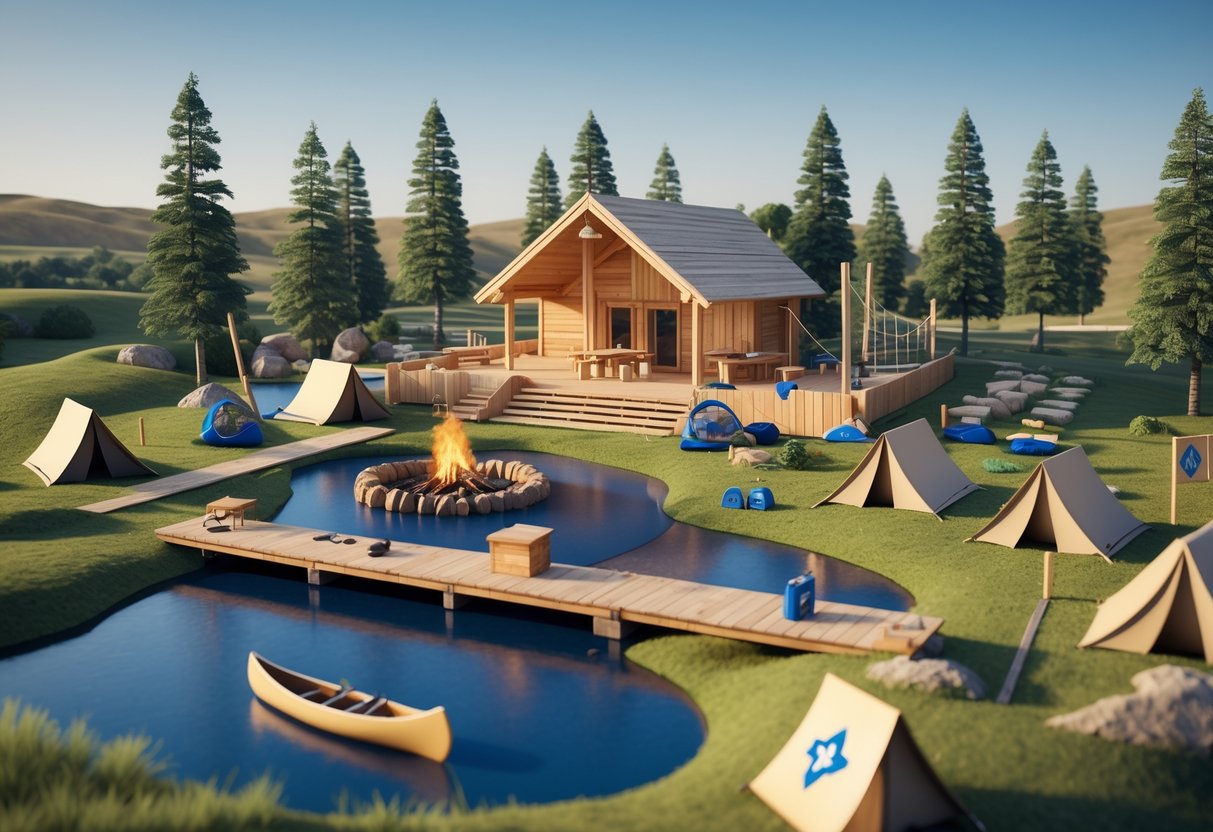
Scouting infrastructure means the physical places, equipment, and systems that help youth programmes run. Think meeting halls, campsites, safety gear, and even the tech that keeps everything running smoothly.
It covers everything from traditional huts and adventure centres to digital tools for organising events. All these things work together so young people can have great experiences.
Key Components of Scouting Infrastructure
Every scouting group really needs its own meeting spaces. Most of us use indoor venues for weekly gatherings, training, and planning.
These spaces usually have storage, kitchen areas, and flexible rooms for different age groups. It’s not always fancy, but it works.
Outdoor facilities matter just as much. Groups often run their own campsites or adventure grounds.
These need toilets, cooking setups, and somewhere to sleep during overnight events. Without these basics, outdoor scouting just doesn’t happen.
We can’t forget about safety systems. Every group needs first aid kits, emergency radios, and clear safety procedures.
Regular checks keep these systems up to date and keep everyone safe.
Equipment storage is always a challenge. Groups store tents, activity gear, badges, and all sorts of supplies.
Good storage keeps things organised and stops gear getting ruined.
Modern scouting leans on digital infrastructure too. Websites, event booking tools, and membership databases all play a role.
Lots of groups use apps now for easier communication and admin.
The Role of Infrastructure in Programme Delivery
If you have decent infrastructure, you can run better programmes. Leaders can plan all sorts of activities, rain or shine.
Young people stay interested when there’s plenty of space and the right equipment for hands-on learning.
Accessibility really matters. Buildings and sites need ramps, good lighting, and space for everyone.
That way, no one gets left out because of a physical barrier.
Flexible spaces make a difference. One hall can host crafts, games, or a big awards night.
Moveable furniture and open layouts let you switch things up fast.
Outdoor facilities give young people the adventure side of scouting. Camping teaches real-life skills, and safe activity areas help them build confidence.
Maintenance is more important than people think. If you keep things in good shape, everyone feels welcome and safe.
Let things slide, and you lose options—plus, it gets riskier.
Modern Trends in Facility Development
Technology is changing how we build and use scout facilities. New buildings often come with charging points, Wi-Fi, and screens for presentations.
These extras add to the experience but don’t replace the classic outdoor stuff.
Sustainability is a big deal now. Solar panels, rainwater tanks, and efficient heating systems cut down on environmental impact.
They also set a good example for young scouts.
Multi-purpose design stretches the budget further. Lots of new buildings double up for wider community use.
Sharing with other groups helps justify the cost and builds local links.
Modular construction is popular for growing groups. Temporary or expandable buildings let you adjust as numbers go up or down.
You spend less up front but still have room to grow.
These days, groups often look for partnerships when building new infrastructure. Sharing spaces with schools or community centres spreads the cost and opens up new resources.
Types of Scouting Infrastructure
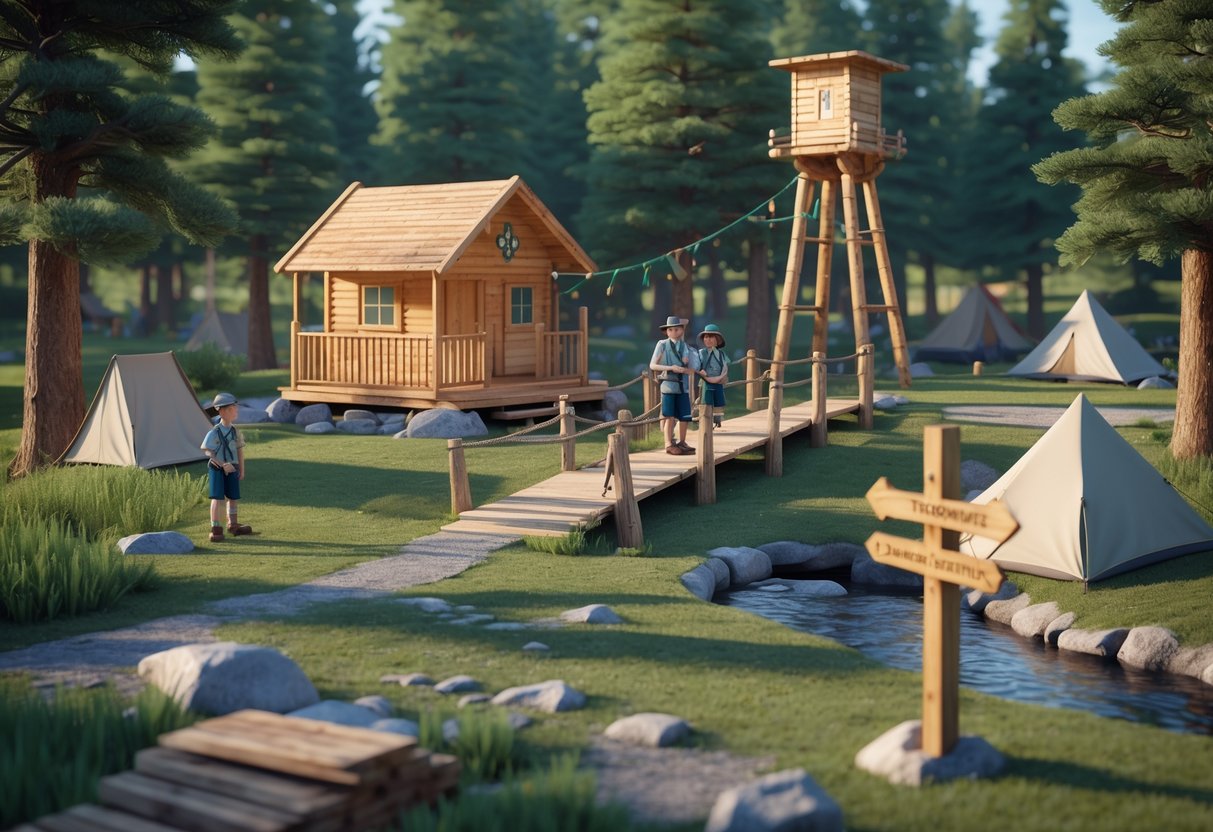
Scouting groups use three main types of physical infrastructure. These range from permanent halls to outdoor adventure centres.
Each one helps build skills and a sense of community.
Campsites and Activity Centres
Campsites are the heart of outdoor scouting in the UK. These sites usually have places to sleep, cook, and sort out basic needs like toilets and showers.
Most groups stick with established campsites that offer tent pitches plus some permanent shelters. Some have bunkhouses for 20-40 people.
Activity centres add more options. You’ll often find:
• High ropes courses and climbing walls • Water sports kit and lake access • Archery ranges with all the gear • Fire pits for outdoor cooking • First aid points and equipment stores
Gilwell Park and Kibblestone are well-known UK centres. They run programmes all year and usually charge £15-25 per person per night, with meals included.
Regional councils often run several campsites for local groups. Weekend camps cost around £8-12 per young person, so it stays affordable.
Scout Huts and Meeting Spaces
Scout huts are where most groups meet every week. These buildings need to be flexible for all ages and activities.
A typical hut has a main hall—about 10×15 metres at least. This is where games, ceremonies, and big group stuff happens.
Storage is key. Most huts have:
• Lockable cupboards for kit and badges • Kitchens for cooking sessions • Extra rooms for smaller meetings • Notice boards for info • Stackable chairs and tables
Newer huts sometimes include special rooms. You might find craft areas with sinks, IT corners with Wi-Fi, or quiet rooms for private chats.
Some groups rent church halls or community centres instead. Renting usually costs £20-40 per session, depending on what’s included.
Outdoor and Adventure Facilities
Special outdoor spaces help scouts learn advanced skills. These facilities cost more but open up bigger opportunities.
Climbing facilities can be indoor walls or real rock faces. Indoor ones are usually 6-8 metres tall with different routes.
Water activity bases need boat sheds, changing rooms, and plenty of safety gear. Typical activities include:
• Kayaks and canoes • Sailing dinghies with safety boats • Paddleboards • Rescue gear and safety talks
Adventure courses push scouts with physical challenges. Zip lines, rope bridges, and team elements all need to meet safety rules.
Lots of districts share mobile equipment. Things like climbing walls on trailers or archery sets help keep costs down for everyone.
Outdoor facility maintenance runs about £2,000-5,000 a year, depending on use and weather. Regular safety checks keep everything up to standard.
Planning Scouting Infrastructure Projects

Planning good infrastructure takes time and a lot of listening. We need to check in with our community, write solid project plans, and talk to local councils early on.
Needs Assessment and Community Consultation
Start every project by figuring out what people actually need. Chat with parents, leaders, and young people about what’s working—and what’s not.
Some helpful questions:
- Which spaces get used most?
- What puts people off?
- Where are we losing potential members?
Walk the site with different groups. Parents might notice safety issues we miss. Young people often have surprisingly good suggestions for making things more fun.
Check your membership trends. If Beavers are booming but Cubs are shrinking, maybe you need different spaces.
Waiting lists can show where the real demand is.
Small projects that solve everyday problems often make a big impact. A new storage shed might sound dull, but it could save loads of time.
Better lighting in the car park helps everyone feel safer at night.
Write down what people tell you. These notes make your funding bids stronger later.
Developing Project Proposals
A good project proposal tells a story: what’s wrong, what you’ll do, and how it helps.
Break big projects into smaller chunks. It’s easier to fund and lets you try things out before going all in.
Make sure to include:
- Cost estimates (get three quotes if you can)
- Timeline with key dates
- Who’s in charge of each part
- Maintenance plans for the future
Write different versions for different people. Funders want numbers and results. Planning officers want technical stuff. Members just want to know how it’ll affect their meetings.
Think about what could go wrong—bad weather, costs going up, delays. Build in extra time and budget just in case.
Even small projects need proper planning. A £5,000 climbing wall still needs solid foundations and safety checks.
Collaboration With Local Authorities
Get in touch with your local council early, before you start applying for permissions. They can tell you what’s possible and what’s not.
Useful contacts:
- Planning officers for building regulations
- Environmental health for kitchens and toilets
- Highways for access and parking
- Building control for safety
Go to parish council meetings and explain your ideas. Local councillors usually like youth projects and might even help you find funding.
Check if your council has grants for sports or youth groups. Sometimes there’s money available if you ask.
Be upfront about things like noise or extra traffic. Show how you’ll handle them—people appreciate honesty.
Keep notes from every meeting and email. Planning can drag on, so you’ll want to remember what was agreed.
Some projects need extra permissions, like tree removal or working near protected areas. Start these chats months ahead.
Funding Sources for Scouting Infrastructure
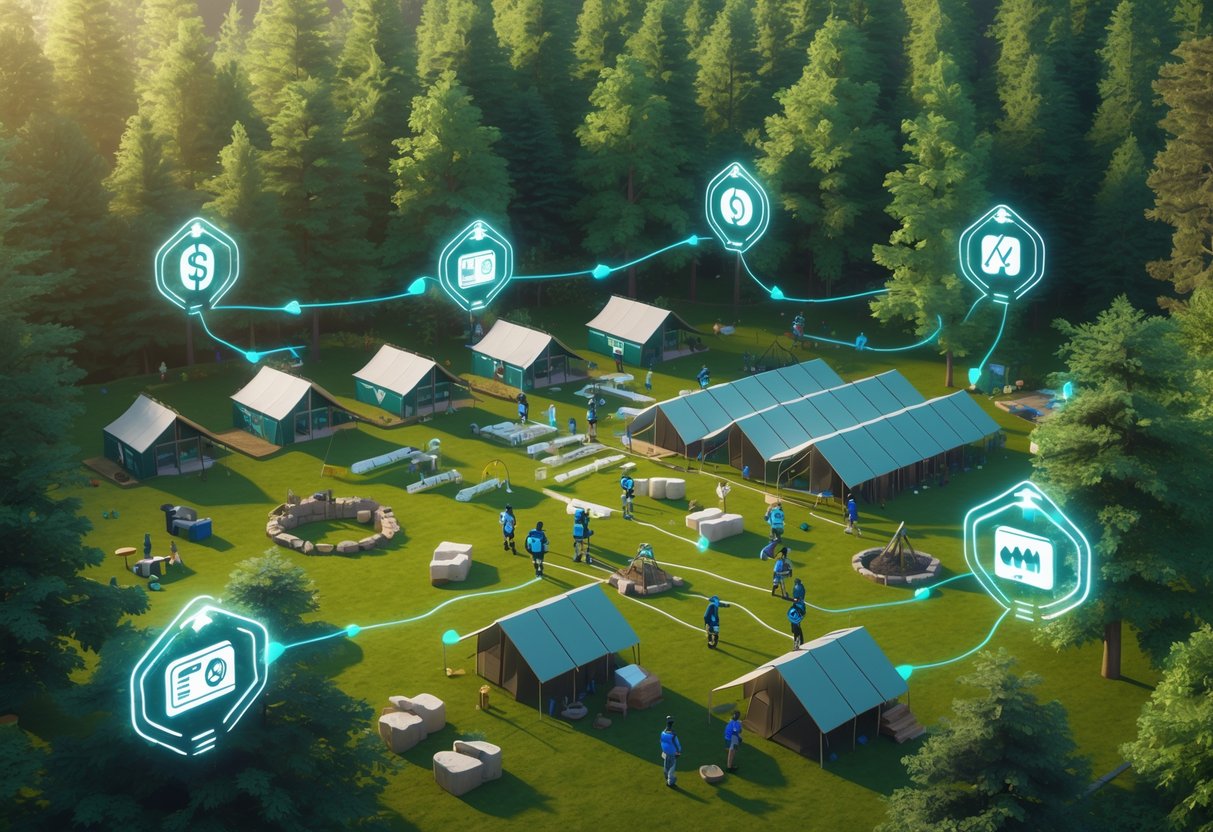
Scout groups can find funding through special Scout programmes like IMP, government grants, and local fundraising. These help groups upgrade facilities, buy equipment, and reach more young people.
IMP Small Capital Projects Fund
The IMP Small Capital Projects Fund gives targeted help to Scout groups working to improve their buildings. It’s for upgrades, not for fixing wear and tear.
Lincolnshire Scouts run a strong IMP programme. Their fund supports small building projects that make a real difference.
Main points about IMP funding:
- For improvements, not repairs
- Focused on buildings and infrastructure
- Usually for smaller projects
- Must show clear benefits to Scouting
Groups need to explain how their project will boost their ability to run programmes. The fund looks for projects that make a lasting impact.
External Grants and Government Schemes
Government grants can offer serious support for Scout projects. The Infrastructure Investment and Jobs Act, for example, has opened up new grants for local communities.
Several government departments offer relevant grants:
Department of Energy – For clean energy and efficiency
Environmental Protection Agency – For environmental improvements
Department of Agriculture – For rural and community development
Department of Transportation – For access and safety upgrades
Corporate foundations are another big source. About 75% of grants to Scout groups come from small foundations with less than £10 million in assets.
The top 10 grant-makers provide 83% of the total value. These foundations often support a mix of youth, education, and community groups.
Fundraising and Community Contributions
Local fundraising is still vital for Scout projects. Most groups mix different sources to get big projects done.
Popular fundraising ideas:
- Community events and sponsored challenges
- Partnerships with local businesses
- Donations from parents and supporters
- Grant applications to local trusts
Some groups run big capital campaigns for new buildings or big renovations. These can take a couple of years and need committed volunteers.
Corporate sponsorships can also help. Local businesses sometimes donate gear, help with improvements, or give money for specific needs.
The most successful groups usually have a long-term plan that blends regular fundraising with strategic grant applications.
Applying for the IMP Small Capital Projects Fund
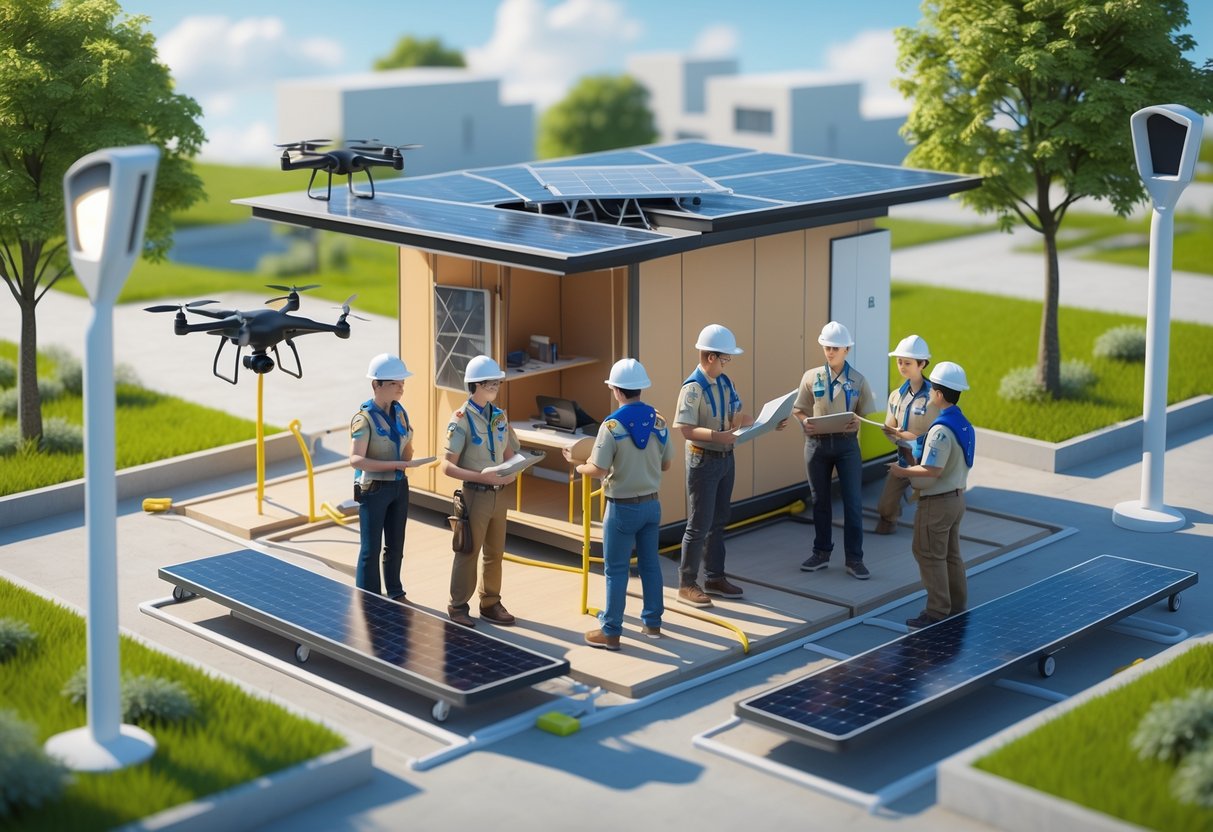
The IMP fund gives up to £2,500 for Scout groups and districts in Lincolnshire to upgrade their buildings and sites. You’ll need to match this amount, meet deadlines, and make sure your premises stay safe to qualify.
Eligibility Criteria
Scout groups and districts within Lincolnshire Scouts can apply for this fund. Individual scouts and organisations outside Lincolnshire can’t access these grants.
Financial Requirements:
- Your reserves shouldn’t exceed 6 months of your annual income.
- You need to provide matching funds equal to the grant amount.
- You must register for Gift Aid or at least be in the process of registering.
Property Requirements:
You must own your premises or hold a lease with over 10 years left. This helps ensure any improvements funded by the grant last for the long haul.
Governance Standards:
Your group needs an effective trustee board with at least a chair and treasurer. Your District Leader Volunteer, Group Leader Volunteer, or Group Chair must endorse your application.
Attach the safe premises checklist to your application. This shows your facilities are already meeting basic safety standards before you start any improvements.
Application and Approval Process
Application Deadlines:
Twice a year, they review applications with these cut-off dates:
| Application Deadline | Review Period | Outcome Notification |
|---|---|---|
| 30 April | May | 30 September |
| 30 September | October | 30 November |
Scoring and Priority:
Reviewers score each application based on merit and potential impact. If several applications arrive at once, they give priority to the first one received.
Funding Restrictions:
You can apply for up to £2,500 per project. The fund doesn’t cover planning fees or architect costs. Each group only gets one shot at this fund.
Projects should focus on improvements, not just repairs. Your application needs to make clear how the project will help more young people access scouting or improve the quality of programmes.
Reporting and Compliance Requirements
Spending Timeline:
You have 12 months from the award date to spend all the grant money. If you don’t use it all, you have to return the leftover funds to Lincolnshire Scout County.
Project Reporting:
Within 3 months of finishing your project, you need to submit a detailed report. Include receipts and evidence showing how you spent the funds and what impact the project had.
Maintenance Planning:
Explain how you’ll maintain any new facilities or equipment bought with the grant. This proves you’re thinking about long-term sustainability and looking after the investment.
Publicity Requirements:
Lincolnshire Scouts will share news about successful grants and projects. You’ll need to help out with any publicity or case studies they request.
The county can withdraw the scheme at any time and makes all final decisions on awards. Once the money runs out, the fund closes until further notice.
Roles and Responsibilities in Infrastructure Projects

Clear leadership and defined roles make scouting infrastructure projects work. Everyone plays a part in building safe, effective facilities for young people.
Trustee Boards and Governance
Trustee boards take responsibility for infrastructure decisions in scouting organisations. They approve big spending and make sure projects match the group’s charitable objectives.
Key governance responsibilities include:
- Setting budgets and fundraising targets
- Approving architectural plans and picking contractors
- Ensuring compliance with charity commission rules
- Managing risk assessment and insurance
Trustees juggle big dreams with financial caution. They often team up with fundraising committees to secure grants from groups like the Scout Association or local councils.
Boards keep a close eye on finances throughout the project. They usually set up sub-committees to track progress and spending.
Regular reporting keeps everyone in the loop. Most projects work best with monthly trustee updates on timelines, budgets, and any new challenges.
Project Management Teams
Project managers run the show from planning to handover. Their technical know-how makes sure projects meet scouting needs and building regs.
Core management responsibilities:
| Role | Primary Tasks |
|---|---|
| Project Manager | Timeline coordination, budget monitoring, stakeholder communication |
| Technical Lead | Design oversight, contractor liaison, quality assurance |
| Health & Safety Officer | Risk assessments, compliance monitoring, site safety |
Good project teams set up clear communication with trustees, contractors, and user groups. Weekly meetings keep everyone on track during busy construction phases.
Resource management means mixing volunteer help with professional contractors. Lots of groups rely on parents for things like painting, landscaping, or fitting out interiors.
Risk management calls for backup plans—bad weather, budget overruns, or contractor hiccups can happen. Experienced managers usually add an extra 10-15% to the time and budget for surprises.
Legal and Regulatory Considerations
Every infrastructure project starts with planning permission and building regulations approval. Local authorities check proposals against development policies and community needs.
Essential legal requirements:
- Planning applications for new builds or big changes
- Building regulations approval for structural, electrical, and plumbing work
- Environmental assessments for larger projects
- Licensing for facilities used by under-18s
You have to think about health and safety, not just during construction but after. Projects must meet accessibility standards under the Equality Act 2010.
Insurance needs attention early on. Most policies don’t cover you during building work, so you’ll need extra protection.
Trustees usually appoint premises officers to handle daily facility operations and compliance checks. Regular safety inspections and maintenance scheduling are part of the job.
Sustainable and Inclusive Infrastructure Development
Sustainable infrastructure isn’t just a buzzword—it’s about creating spaces that work for everyone and look after the environment. That means using eco-friendly materials, making things accessible, and bringing in new tech that saves money over time.
Environmental Considerations
We really need to think about the environment when building scouting infrastructure. Choosing renewable energy like solar panels and low-carbon materials makes a big difference.
Water-saving systems help too. Rainwater tanks and greywater recycling can cut water use by almost half at camps.
Green building practices use local timber and recycled stuff when possible. That cuts down on transport emissions and supports local businesses.
Switching to energy-efficient lighting and heating saves money and reduces your carbon footprint. LEDs, for example, use much less power and last longer.
If we design facilities to fit the landscape, we protect local habitats and create better outdoor spaces for scouts.
Accessibility and Diverse Needs
Scouting spaces should welcome everyone, no exceptions. That means making sure wheelchair users can get around and providing for different cultural needs.
Key accessibility features include:
- Ramps to all buildings
- Wide doors and corridors
- Accessible toilets and wash areas
- Clear signs with both visual and tactile info
Quiet spaces matter too. Some scouts need a break from the noise, and these areas help everyone join in.
Some groups might need things like prayer rooms or special kitchens. Planning for diversity from the start is cheaper than fixing things later.
And don’t forget age differences—young scouts need lower toilets and handrails than older ones.
Sustainable Materials and Innovation
New materials can be both strong and eco-friendly. Cross-laminated timber, for example, is as tough as steel but stores carbon instead of producing it.
Smart tech helps manage resources:
- Sensors adjust heating based on who’s there
- Apps track water and energy use
- Automated systems cut down on waste
Modular construction makes it easy to expand or change spaces as needs shift. That saves money and materials over time.
Using local materials keeps costs and environmental impact down. Plus, local stone or timber helps buildings blend in.
Adding renewable tech like ground-source heat pumps or solar water heaters costs more upfront, but you save loads over the years.
Case Study: Lincolnshire Scouts Infrastructure Improvements

Lincolnshire Scouts has upgraded local facilities by combining smart funding with community partnerships. Their approach shows how targeted investment and teamwork can make a real difference for young people.
Success Stories From Local Groups
The IMP Small Capital Projects Fund drives infrastructure improvements across Lincolnshire. It funds upgrades, not just repairs, so Scout groups can boost their facilities for better programmes.
Bourne and Morton Scout Hut is a standout example. The group worked with Minster Group and Balfour Beatty through the Lincolnshire County Council Highways Volunteering Scheme to improve accessibility.
Here’s what they achieved:
- Used 200 tonnes of recycled materials
- Completely rebuilt the car park
- Made the site more accessible for all ages
- Cut environmental impact by recycling materials
Martin Siddle from the Five Acre Field Committee said the changes made the facility “much more user friendly for all ages.” Partnerships really stretched their resources and expertise.
Lincoln District tackled financial barriers by setting up a special fund. They make sure no young person misses out on Scouting due to family circumstances, proving that inclusion is a kind of infrastructure too.
Lessons Learnt From Past Projects
Successful projects in Lincolnshire have a few things in common. Partnerships are key, as shown by Bourne and Morton’s work with local authorities and businesses.
Environmental choices matter for more than just the project itself. Using recycled materials cut down on new resources and transport emissions, without sacrificing quality.
Community focus leads to better outcomes. When projects improve accessibility and user experience, they serve more people—not just scouts.
By focusing on improvements, the IMP fund helps groups move forward instead of just patching up old facilities. This keeps Scout infrastructure up to date with changing needs and safety standards.
Good planning and material coordination kept the Bourne project running smoothly. Multiple deliveries and careful scheduling meant fewer delays, showing how important project management is for Scout leaders.
Maintenance and Upgrading of Existing Facilities

Keeping scouting infrastructure in good shape takes regular care and smart upgrades. Routine maintenance stops little issues from turning into expensive repairs, and planned improvements boost safety and programme quality.
Routine Maintenance Practices
Regular checks keep facilities safe and ready for use. We need simple systems to catch small problems before they grow.
Daily and weekly checks cover basics like emergency exits, lighting, and outdoor equipment. Rangers and volunteers should note any issues right away.
Seasonal maintenance tackles weather-related wear and tear. Before and after camp season, check roofs, plumbing, and heating. In winter, drain pipes and secure outdoor gear.
Servicing equipment according to manufacturer instructions keeps things running. Get kitchen appliances, water heaters, and electrics checked by pros every year.
Maintenance logs help track repairs and replacements. Keeping records makes it easier to spot patterns and budget for the future.
Planning Upgrades and Expansions
Good upgrades start with a look at current conditions and what the programme needs now and in the future. We have to weigh immediate fixes against bigger plans.
Needs assessments highlight what to fix first. Ask leaders about programme limits and safety worries. Factor in accessibility and changing interests.
Budget planning spreads costs out over several years. Big projects like new buildings need serious funding, so breaking them into phases can help.
Prioritise safety-critical upgrades before anything cosmetic. Utilities, structure, and accessibility come first. Equipment that directly affects activities should be high on the list.
Schedule big projects during off-peak times. Avoid major work during busy camp periods. Smaller upgrades can fit between bookings.
Ensuring Safety and Compliance
Legal requirements and accessibility standards often drive infrastructure changes. We need to keep up with the rules while making spaces welcoming for everyone.
Building codes differ by location and project size. Major works usually trigger new requirements, so talk to local authorities early.
Accessibility upgrades make facilities usable for everyone. Ramps, accessible toilets, and clear paths help all users, not just those with disabilities.
Fire safety systems need regular checks and updates. Test alarms, extinguishers, and emergency lights. Update evacuation plans as facilities change.
Insurance can depend on your maintenance standards. Some insurers require specific checks or upgrades. Good records prove compliance and might even lower premiums.
Technological Innovations in Scouting Infrastructure
Modern scouting infrastructure uses smart building systems to automate operations, AI to predict maintenance needs, and digital platforms to streamline project management. These new tools are really changing how we build, run, and maintain facilities for scouts.
Smart Building Features
Smart buildings rely on sensors and automated systems to shape efficient, responsive environments. These features cut energy costs and boost safety and comfort for scouts and leaders.
Automated lighting systems tweak brightness depending on occupancy and sunlight. Motion sensors flip lights on when someone walks in and switch them off when the room empties.
We set up different lighting zones for activities like meetings, crafts, or prepping for the outdoors.
Climate control systems keep temperatures comfortable without much fuss. Smart thermostats pick up on usage patterns and start heating or cooling before groups arrive.
Temperature sensors in each zone help keep the whole building at a steady comfort level.
Security systems offer keyless entry, cameras, and alarm monitoring. Digital codes let us give visiting groups access—no need to hand out keys.
Cameras keep an eye on outdoor areas and parking for added safety.
Energy monitoring lets us track electricity, gas, and water use in real-time. We spot which systems eat up the most energy and find ways to trim costs.
Solar panels and battery storage give us renewable energy options.
AI and Data-Driven Management
Artificial intelligence helps us spot maintenance issues before they get expensive. Data analysis uncovers usage patterns that help us make smarter decisions about improvements.
Predictive maintenance relies on sensors that check equipment health. HVAC, plumbing, and electrical systems send alerts when something needs attention.
This stops breakdowns during big events and keeps emergency repairs from piling up.
Usage analytics show us how different spaces get used throughout the year. We figure out which rooms stay busiest, when usage peaks, and what needs an upgrade.
This data shapes our plans for renovations and expansions.
Cost optimisation algorithms look at utility bills, maintenance records, and usage data. AI points out the best times to run energy-heavy activities or when to replace old equipment.
We can test out different scenarios before making big investments.
Safety monitoring systems use cameras and sensors to catch hazards early. Smoke detectors, water leak sensors, and structural monitors send warnings before things get serious.
Emergency response systems can even call local services automatically if problems come up.
Digital Tools for Project Coordination
Digital platforms make planning, executing, and tracking infrastructure projects smoother. These tools keep contractors, volunteers, and scout leaders connected, helping projects stay on schedule and within budget.
Project management software tracks timelines, budgets, and milestones for construction or renovation. We assign tasks, set deadlines, and check progress as it happens.
Popular platforms like Microsoft Project, Asana, and Trello suit different project sizes.
Communication platforms keep everyone in the loop about updates and changes. Slack or Microsoft Teams offer instant messaging and file sharing.
We set up separate channels for different project areas.
Document management systems store blueprints, permits, contracts, and inspection reports in the cloud. Version control keeps everyone working with the latest documents.
Mobile apps let supervisors check plans and update progress from anywhere.
Budget tracking tools watch expenses against approved budgets. We get alerts when spending nears the limit and can track overruns by category.
Connecting with accounting software makes financial reporting and approvals easier.
Measuring the Impact of Scouting Infrastructure Investments
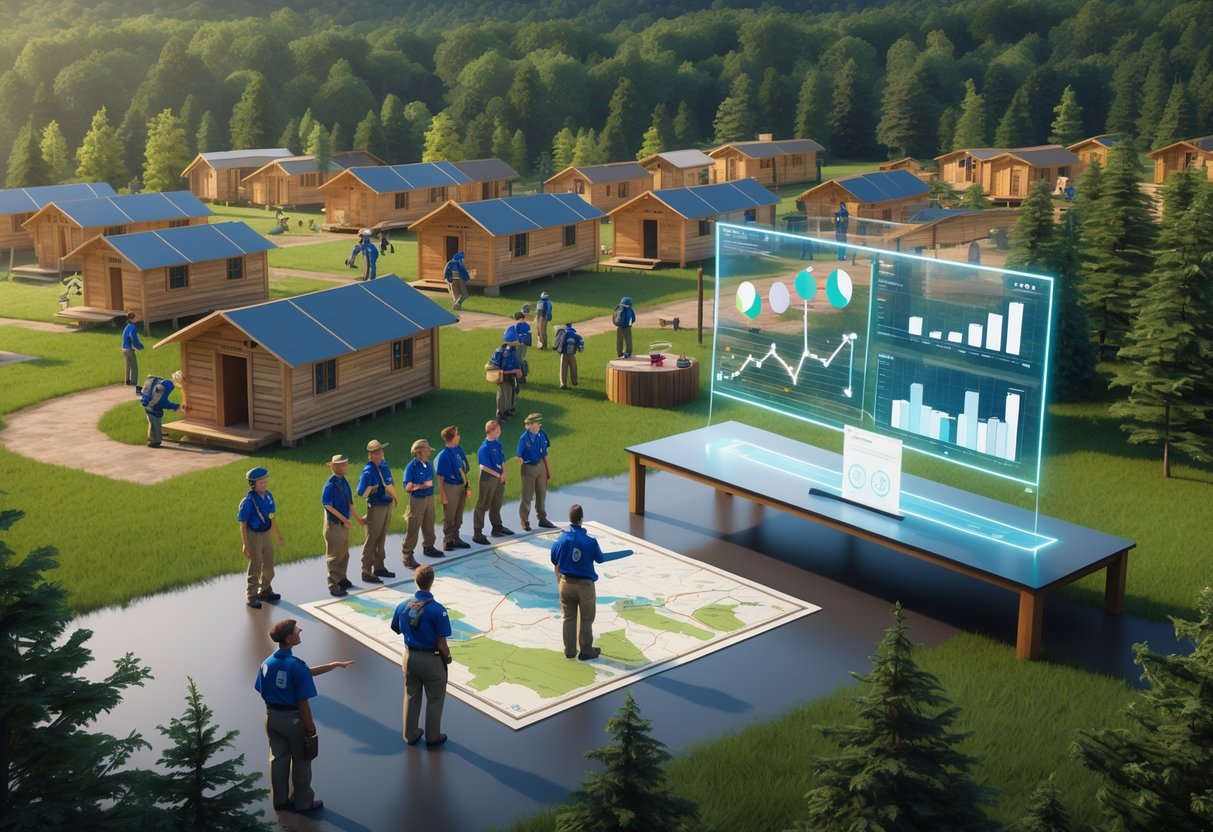
We track both membership growth and programme quality to measure impact. Concrete data shows how facility upgrades, equipment, and training lead to better outcomes for young people.
Tracking Growth and Participation
We watch membership trends before and after investing in infrastructure. New or improved facilities often bring a bump in enrollment within six to twelve months.
Key metrics include:
- Total membership numbers by age group
- Retention rates year-over-year
- Activity participation levels across programmes
- Waiting list lengths for popular activities
Research tells us Scouts outscore non-Scouts on 13 out of 14 development outcomes, giving us a solid baseline.
We compare attendance patterns at upgraded facilities to older ones. Better spaces usually see 15-25% higher attendance.
We also track community engagement through open events and family involvement.
Digital systems help us track these numbers automatically. Many groups use online registration platforms that generate reports on trends and programme popularity.
Quality Improvements in Scouting Delivery
We check programme quality with participant feedback and standard outcomes. Infrastructure upgrades should make a real difference for young people.
Quality indicators include:
- Fewer safety incidents
- More programme variety and frequency
- Leaders feeling more confident
- Youth moving forward in award schemes
Studies with over 7,000 young people show Scouts consistently do better in personal development. We use these benchmarks to measure our own programmes.
We survey participants every quarter about their experiences—covering facility conditions, activity quality, and what they’ve gained. Leaders fill out similar assessments on how well they can deliver programmes.
Recognition from councils, educational partners, and community groups signals programme effectiveness after infrastructure improvements.
Frequently Asked Questions

Professional scouting systems depend on advanced tech platforms, data analysis, and wide talent identification networks. Training varies from formal qualifications to specialised certifications, while sustainable networks need ethical frameworks and inclusive recruitment practices.
What are the essential components of a modern scouting system in sports?
Modern scouting systems need three main things to work well. We need solid databases that track player stats, performance metrics, and injury histories over multiple seasons.
Video analysis platforms are key for today’s scouting. Scouts use them to review footage, make highlight reels, and compare players side-by-side with standard criteria.
Communication networks link scouts across regions and competition levels. Cloud reporting systems make sure talent data gets to decision-makers quickly and securely.
Mobile apps let scouts collect data during matches. They can record observations, rate performances, and upload photos right from the sidelines.
How has technology impacted the effectiveness of talent identification?
Technology has really changed talent identification. We can now track things we couldn’t before with GPS, heart rate monitors, and motion capture.
AI algorithms review thousands of hours of match footage automatically. They spot patterns in player behavior and skills that human scouts might overlook.
Databases store info on millions of players worldwide. Scouts search for specific traits, compare players across leagues, and find emerging talent in new markets.
Video conferencing makes remote scouting for international players possible. This saves on travel and widens the talent pool.
Could you explain the role of data analysis in improving scouting procedures?
Data analysis takes the guesswork out of talent evaluation by giving us objective performance numbers. We use stats to predict future performance from current and past data.
Performance analytics reveal hidden strengths and weaknesses. Heat maps show positioning, and passing accuracy stats highlight technical consistency under pressure.
Injury prediction models use training and match data to flag players at risk. Clubs use this info to make smarter long-term investments.
Comparison algorithms let us benchmark players against standards for their position and age. Scouts can spot overperformers in lower divisions who might move up.
What training is required for someone to become a professional scout?
Professional scouts usually need formal qualifications in sports science, coaching, or similar fields. Most football associations require certified scouting courses for credentials.
Getting hands-on experience through volunteer scouting at youth or amateur levels builds essential skills. We suggest starting with local clubs to learn observation and reporting.
Learning specialised software is more important now than ever. Scouts need to know video analysis tools, statistical software, and mobile data apps.
Ongoing education keeps scouts up to date with new methods. Annual recertification covers new tech, rule changes, and best practices.
How do clubs ensure their scouting networks are inclusive and diverse?
Inclusive recruitment means advertising scouting jobs in a variety of places and communities. We actively look for candidates from different backgrounds, genders, and ethnicities.
Training programmes help scouts spot and overcome unconscious bias. This keeps assessments fair for players from all backgrounds.
Diverse scouting teams bring fresh perspectives to talent decisions. Mixed-gender and multicultural groups notice talent that others might miss.
Community partnerships with grassroots organisations open doors to underrepresented groups. These connections help us find talented players outside traditional pathways.
What are the best practices for maintaining a sustainable and ethical scouting network?
We run sustainable scouting networks by sticking to clear budgets and making sure we get the most out of every effort.
We focus on the activities that really matter. Technology helps us cut down on costs without sacrificing quality.
Ethical guidelines shape every interaction with young players and their families. Every scout has to finish safeguarding training and stick to strict protocols when working with minors.
We keep communication transparent to avoid giving players or parents false hope. You’ll always get honest feedback about prospects, and we never make promises we can’t keep.
We regularly audit the network to spot what’s working and what’s not. These reviews look at both how well we use resources and whether we’re following ethical standards.
Long-term planning keeps the network steady, even if coaches change or budgets shift. We rely on well-documented processes instead of just individual know-how or personal connections.

